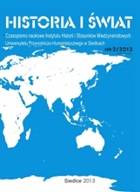Mechanizmy instalowania władzy i administracji komunistycznej na przykładzie działalności Juliana Grobelnego jako starosty mińskiego (10 października – 5 grudnia 1944 r.)
DOI:
https://doi.org/10.34739/his.2013.02.07Słowa kluczowe:
History, Julian Grobelny, Mińsk Mazowiecki, ŻegotaAbstrakt
This paper addresses the problem of the mechanism of formation of Polish communist authorities in 1944. For that purpose the author used the example of Julian Grobelny, the first governor in the district of Minsk Mazowiecki after the arrival of the Red Army in the areas of the region, a politician and socialist activist, who during World War II, against the policies conducted by the party of which he was a member (PPS-WRN) [PSP- FEI], engaged in the construction of political alliances with activists and fighters of PSL, RPPS and PPR [Polish Workers' Party], opting for an alliance with the Soviet Union by fighting alongside the Red Army. Consistent selection of J. Grobelny during the German occupation influenced the career of the activist who through underground contacts with activists coming from this environment associated with the People’s Army and the left side of PPS, supporting KRN and PRWN - RPPS. After the expulsion of the Germans from the right-bank part of the Warsaw province, he was appointed as governor in the district of Minsk Mazowiecki. When conducting this function, he made decisions about looting mansions, and, de facto, he was a predecessor in taking over and securing the property of landlords. On the basis of the decisions issued by J. Grobelny, officials enforced the confiscation of the property at least in five mansions, leading to the statisation of paintings and furniture created between the seventeenth and nineteenth century. J. Grobelny, during the war the President of the “Żegota” Council for Aid to Jews, awarded with the Medal of the Righteous Among the Nations, after the end of hostilities, took part in the liquidation of the landed gentry, acting to the detriment of his own nation.
Pobrania
Pobrania
Opublikowane
Numer
Dział
Licencja
Prawa autorskie (c) 2013 Historia i Świat

Utwór dostępny jest na licencji Creative Commons Uznanie autorstwa – Bez utworów zależnych 4.0 Międzynarodowe.




